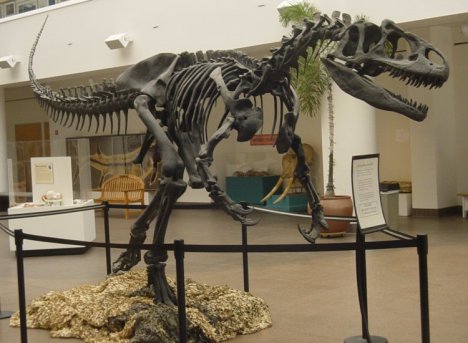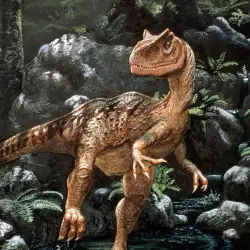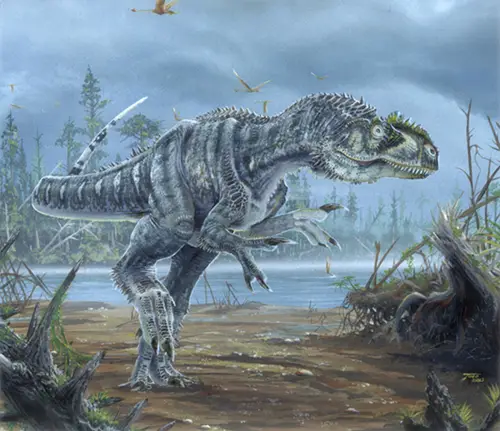Allosaurus was the largest land carnivore of its time.
Table of Contents
Allosaurus, which predated Tyrannosaurus Rex by some 85 million years, was the largest land predator of the late Jurassic Period. The 38-foot long, 17-foot tall Allosaurus even towered over fellow predators like the horn-nosed Ceratosaurus, who was a fairly intimidating 10-12 feet in height and 15 to 20 feet in length. Four different species of Allosaurus have been classified, and the largest, Allosaurus Amplexus, may have weighed up to five tons.

Allosaurus walked on two bird-like feet, balancing with its tail, and its short forearms ended in three six-inch talons. The three-foot-long head contained dozens of serrated teeth. Above the eyes were bony ridges. A single Allosaurus probably was no match for the gargantuan herbivore Diplodocus, who was 90 feet from head to tail, or the “thunder lizard” Brontosaurs (70 feet), but Allosaurus may have hunted in packs, and was certainly a threat to young, injured or old sauropods. Even the spike-tailed Stegosaurus probably gave this carnosaur a wide berth, as one bite from Allosaurus could have easily severed the plant-eaters tiny head.
Allosaurus Dinosaur Fun Facts
Living mainly in the late Jurassic Period, Allosaurids were the most common predator in North America at the time. Allosaurus stood on two sturdy legs, had a large head, and held its big tail out to balance its body. It could grow up to 39 feet in length. It also had two small forearms, but unlike similar dinosaurs with more feeble front limbs, Allosaurus’ front limbs ended in hands armed with three large, strong claws.
- Its name means “different lizard” because the vertebrae of its spine are different from those of other, similar dinosaurs.
- It was a meat-eater, and groups of Allosauruses probably joined together in packs to hunt larger sauropods.
- It could unhinge its flexible jaws like a snake to eat huge chunks of meat that it bit off of its prey with its long, serrated teeth.
An animatronic Allosaurus at Brookfield Zoo in Chicago measures 39.60′ long x 6.60′ wide x 11.22′ tall.
Jurassic Period
Allosaurus’ heyday was during the late Jurassic Period, about 150 to 140 million years ago, where this theropod dinosaur trolled the lush swamps and sub-tropical forests in search of prey. The earth’s geography was very different; the great landmass known as “Pangea” (Greek for “all land”) had gradually broken apart, causing the continents to slowly drift farther and farther from one another. Greenland was sandwiched between the eastern coast of North America and the western coast of Europe, and South America and Africa were about one-third their current distance. Huge sharks and marine crocodiles swam through the oceans.
Different Lizard
It is interesting to note that this dinosaur’s name means ‘different lizard’. The ‘different’ in ‘different lizard’ probably comes from its unusual vertebrae, which was much lighter than those of other dinosaurs during the time. The Allosaurus lived in the late Jurassic period, dating back to nearly 150 million years ago!

The dinosaur was named in 1877, by Othniel Marsh who pronounced the name ‘al-oh-saw-rus’. The fossils were discovered in Colorado, USA. Fossils of the Allosaurus were discovered in Colorado, Montana, and New Mexico. They have been unearthed in North America, Europe, Africa, and even Australia.
The Allosaurus was a carnivore that ate stegosaurs and even iguanodonts that ate plants and headed the predator list. The Allosaurus was 12 m long and 10 ft in height, at the hips. It weighed between 4 and 4.5 tons! The Allosaurus was a feared predator and made quite a scary sight with its huge head and saw edge like socket set teeth. The lizard-hipped dinosaur had short arms. It had hands with three fingers on each and this feature made it an advanced theropod of the age. The Allosaurus belonged to the phylum ‘Chordata‘, which implies that it had a hollow nerve chord that culminated in a brain.
Allosaurus Origins
The Allosaurus a member of the Allosaurid family was first discovered during the closing years of the 19th century by Othniel Charles Marsh in 1877. It existed in the late Jurassic period about 150 million years ago and almost all of its fossils have been in the Morrison Formation in North America, as well as in Portugal and Tanzania. The name Allosaurus means “different lizard” and is derived from the Greek root word “allos” meaning “different”.

Allosaurus was discovered and named in the 1870s by paleontologist Othniel C. Marsh. Allosaurus means “different lizard,” so-called by Marsh because of the creature’s lighter vertebrae and s-shaped neck (Enchanted Learning). A great number of Allosaurus fossils, as well as those of Brontosaurus and many other dinosaurs, have been found in the Morrison Formation, a vast expense of rock extending over 12 states, primarily Montana, Wyoming Colorado, and New Mexico, as well as into the Canadian provinces of Saskatchewan and Manitoba. This quarry is located on the former coast of a shallow sea that covered much of western North America about 200 million years ago. The soft sand at the edge of this ancient ocean provided an ideal environment for the preservation of fossils. A nearly complete Allosaurus skeleton was discovered by a Colorado rancher in 1883.
Taxonomy
Like most dinosaurs, the Allosaurus is believed to have had many variations of it’s kind. Scientists have thus far classified about seven dominant kinds of which some of the prominent types include Allosaurus Fragilis, Allosaurus Atrox, Allosaurus Maximus, Allosaurus Amplexus.
Physical Features
In terms of physical structure, the allosaurus like most theropods was of high stature. It’s believed to have grown to about 30ft tall and is almost 40ft in length. Like the T-rex, the most striking feature had to be the size of its skull which was enormous compared to the size of its much shorter neck. Again like the Tyrannosaurus the Allosaurus possessed a huge tail (acted as a counterbalance) and tiny forelimbs consisting of three fingers. It’s estimated weight was around 2.3 metric tons.
Skull & Teeth
The skull of the Allosaurus was estimated to be around 33 inches in length giving it a decent-sized jaw size. Each premaxilla (the bones forming the tip of the snout) held five teeth and each maxilla (the bones in the upper jaw) and dentary (the bones of the lower jaw) had around 14 to 17 teeth giving the Allosaurus plenty of teeth for the size of its skull.
The teeth became shorter, narrower, and more curved as you went towards the back of the skull and were probably constantly replaced during its lifetime. It’s no wonder that teeth comprised a significant proportion of the excavated remains of an Allosaurus.
Some other interesting features about the Allosaurus include the presence of 2 horns that sat above and in front of the eyes and the fact that it had some of the best-developed sinuses and smelling abilities of the theropods.
Behavioral Patterns & Hunting
Scientists have been united in the fact that the Allosaurus was a voracious predator and one of the most feared marauders amongst the dinosaurs. Their preferred victims were herbivorous (plant-eating) dinosaurs like the Sauropods, Ornithopods, and the Stegosaurids.
Out of the above, it’s thought that the Sauropods were probably their most favored food item, due to the extensive presence of Sauropod remains on the teeth of Allosaurus fossils. In the case of Sauropods, studies have shown that the Allosaurus probably tore the flesh off from living Sauropods deferring the kill of its prey for some time.
In terms of hunting behavior, it’s believed that the Allosaurus usually hunted in groups and their huge tail was also a vital component in aiding the trapping of other dinosaur variants as prey. This hunting in groups is attributed as a unique feature in the Allosaurus as it has been observed that most vertebrates do not usually hunt in groups.
This carnivorous dinosaur was also extremely protective about its young, often hunting and gathering food for them till they were fully grown and capable of looking after themselves.
Anti Social
The Allosaurus, like most Theropods, was not very social and is believed to have been exceptionally preserved. This meant that even interactions with other dinosaurs of their own kind were met with distaste. Some scientists believe that the Allosaurus often wounded members of its own clan if any miscommunication or misunderstanding happened. The results of these interactions could often be fatal.
Several scientists believe that the Allosaurus may even have scavenged off the remains of other dead or immobilized Allosaurus dinosaurs.
Allosaurus Young
One of the key differences between the adult and child Allosaur was the huge difference in hind limb length. The hind limbs of a child allosaurus were often considerably longer than the adults which allowed them to move swiftly and catch much smaller and faster types of prey. This would suggest that as the Allosaurus matured it would start hunting larger and stronger prey as it would be incapable of capturing the faster dinosaurs that it might have hunted when younger.
Sources
- Benton, Michael. The Dinosaur Encyclopedia. New York: Wanderer Books, 1984. 20, 26-27, 37.
- Bakker, Robert T. The Dinosaur Heresies. New York: William Morrow and Co., Inc., 1986. 34-38, 108, 264.
- Hoesch, William A. and Steven A. Austin. “Dinosaur National Monument: Jurassic Park or Jurassic Jumble?” Institute for Creative Research. 8 April 2008.
- “Allosaurus.” Enchanted Learning. 8 April 2008.
